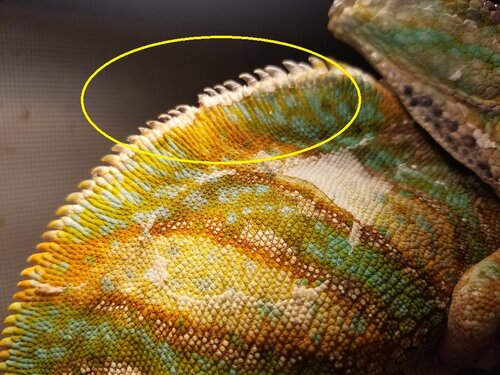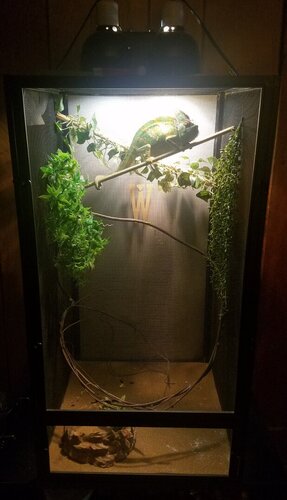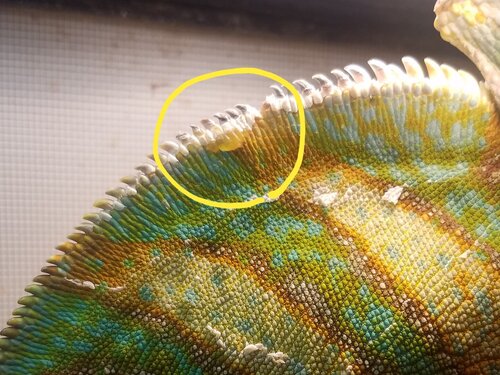Navigation
Install the app
How to install the app on iOS
Follow along with the video below to see how to install our site as a web app on your home screen.
Note: This feature may not be available in some browsers.
More options
You are using an out of date browser. It may not display this or other websites correctly.
You should upgrade or use an alternative browser.
You should upgrade or use an alternative browser.
Dorsal crest question.
- Thread starter OG Style
- Start date
nightanole
Chameleon Enthusiast
This is normal, and you will get weird blackening on all ridges of the head too. You may have a bit of a shed problem, im not going to tell you to try to peel that section off, but ive had no problem doing it, ridge spikes sometimes just wont pop off the shed cap.
If it was a burn, it would be puffy/oozy etc, just like if you got burned.
If it was a burn, it would be puffy/oozy etc, just like if you got burned.
Last edited:
MissSkittles
Chameleon Enthusiast
I can’t answer about the spikes, it I do know that you shouldn’t help them remove their shed unless it’s formed a constricting band (usually around legs and tail) that is impairing circulation.I do try to help him get the shading off, but he doesn't like it. Does the blackening or having the spikes fall off hurt them?
Brodybreaux25
Chameleon Enthusiast
If that’s the case then you should look into correcting the root cause of the shedding problem so you don’t have to assist at all.The shed only has trouble coming off of the caps that are black.
Can you please describe your supplement and gutload schedule?
MissSkittles
Chameleon Enthusiast
What are you feeding the crickets?He eats crickets and lettuce. I use calcium on his crickets daily and calcium D3 and vitamins every few weeks.
The crickets are feed bread.
Please watch this video to learn how to properly gutload bugs.
MissSkittles
Chameleon Enthusiast
I would suggest filling out the help form just to ensure that all of your husbandry is correct. Often things are off which can lead to big problems later. 
Here is some recommended information to include when asking for help in the health clinic forum. By providing this information you will receive more accurate and beneficial responses. It might not be necessary to answer all these questions, but the more you provide the better. Please remember that even the most knowledgeable person can only guess at what your problem may be. Only an experienced reptile veterinarian who can directly examine your animal can give a true diagnosis of your chameleon's health.
Chameleon Info:
Cage Info:
Current Problem - The current problem you are concerned about.
--------------
Please Note:
Here is some recommended information to include when asking for help in the health clinic forum. By providing this information you will receive more accurate and beneficial responses. It might not be necessary to answer all these questions, but the more you provide the better. Please remember that even the most knowledgeable person can only guess at what your problem may be. Only an experienced reptile veterinarian who can directly examine your animal can give a true diagnosis of your chameleon's health.
Chameleon Info:
- Your Chameleon - The species, sex, and age of your chameleon. How long has it been in your care?
- Handling - How often do you handle your chameleon?
- Feeding - What are you feeding your cham? What amount? What is the schedule? How are you gut-loading your feeders?
- Supplements - What brand and type of calcium and vitamin products are you dusting your feeders with and what is the schedule?
- Watering - What kind of watering technique do you use? How often and how long to you mist? Do you see your chameleon drinking?
- Fecal Description - Briefly note colors and consistency from recent droppings. Has this chameleon ever been tested for parasites?
- History - Any previous information about your cham that might be useful to others when trying to help you.
Cage Info:
- Cage Type - Describe your cage (Glass, Screen, Combo?) What are the dimensions?
- Lighting - What brand, model, and types of lighting are you using? What is your daily lighting schedule?
- Temperature - What temp range have you created (cage floor to basking spot)? Lowest overnight temp? How do you measure these temps?
- Humidity - What are your humidity levels? How are you creating and maintaining these levels? What do you use to measure humidity?
- Plants - Are you using live plants? If so, what kind?
- Placement - Where is your cage located? Is it near any fans, air vents, or high traffic areas? At what height is the top of the cage relative to your room floor?
- Location - Where are you geographically located?
Current Problem - The current problem you are concerned about.
--------------
Please Note:
- The more details you provide the better and more accurate help you will receive.
- Photos can be very helpful.
Chameleon Info:
Cage Info:
- Your Chameleon - The species, sex, and age of your chameleon. How long has it been in your care?
- Veiled chameleon, Male, 3 years old, 3 years
- Handling - How often do you handle your chameleon?
- Every few days
- Feeding - What are you feeding your cham? What amount? What is the schedule? How are you gut-loading your feeders?
- Crickets and lettuce. About 10 large crickets every morning. The crickets are feed bread.
- Watering - What kind of watering technique do you use? How often and how long to you mist? Do you see your chameleon drinking?
- He has a water bowl. I mist the cage through out the day. I have seen him drink water
- Fecal Description - Briefly note colors and consistency from recent droppings. Has this chameleon ever been tested for parasites?
- Brown and white. He has never been tested
- History - Any previous information about your cham that might be useful to others when trying to help you.
Cage Info:
- Cage Type - Describe your cage (Glass, Screen, Combo?) What are the dimensions?
- Screen cage. I'm not sure about the size but it is pretty tall.
- Lighting - What brand, model, and types of lighting are you using? What is your daily lighting schedule?
- I use uva and uvb bulbs. The lights come on around 6am and are turned off around 9pm.
- Temperature - What temp range have you created (cage floor to basking spot)? Lowest overnight temp? How do you measure these temps?
- Humidity - What are your humidity levels? How are you creating and maintaining these levels? What do you use to measure humidity?
- Plants - Are you using live plants? If so, what kind?
- None
- Placement - Where is your cage located? Is it near any fans, air vents, or high traffic areas? At what height is the top of the cage relative to your room floor?
- The cage is in a now traffic area away from the vents. The top of the cage is about 4ft.
- Location - Where are you geographically located?
- Ohio.
MissSkittles
Chameleon Enthusiast
Could you please post a photo of the entire enclosure?
The Wild One
Chameleon Enthusiast
Empty space is wasted space, you need way more coverage and horizontal branch’s asap
JackRipper
Avid Member
He would love a couple ficus trees or umbrellas Check out the non toxic plant list. I use declorinator/waterconditioner with beneficial bacteria and slime coat made for tropical fish in every drop of water that my chams use. They never have shed problems and It even seems to make my humidifiers last forever and misting nozzles never really clog up due to the lubricative properties of the conditioned water.
nightanole
Chameleon Enthusiast
It looks like he might be getting an infection. This is new. It wasn't there yesterday.
That looks like a burn. He is getting too close to the heat lamp, so you will need to angle it and even raise it up, or lower the branch.
And yes thats a pretty cage setup. YOu could at least get a decent sized potho plant and just throw it all over the sticks.
MissSkittles
Chameleon Enthusiast
So it looks like you’ve got the dreaded chameleon kit. Contrary to what the pet store told you, it is not adequate for a chameleon. You’re going to need to make many upgrades. The first and most important are lighting and supplements.
Attaching all of the care sheets I think will help you. You may also want to check out this podcast. Very informative. https://www.chameleonbreeder.com/
Also posting a pic comparing a 16x16x30 enclosure to a 24x24x48.
And most important of all, feel free to ask as many questions as you need.
I know I’ve thrown a lot at you. The most important thing to upgrade ASAP is lighting and supplements. The rest is very important too, but if need be, can be done as soon you are able.Chameleon Info:
Supplements - What brand and type of calcium and vitamin products are you dusting your feeders with and what is the schedule?
- Your Chameleon - The species, sex, and age of your chameleon. How long has it been in your care?
- Veiled chameleon, Male, 3 years old, 3 years
- Handling - How often do you handle your chameleon?
- Every few days
- Feeding - What are you feeding your cham? What amount? What is the schedule? How are you gut-loading your feeders?
- Crickets and lettuce. About 10 large crickets every morning. The crickets are feed bread. It’s best to feed in the morning so they have time to digest, so that’s good. Crickets are ok, but like us, chameleons like and need a little variety. Silkworms and roaches (Dubia or discoid) are the best for nutrition. Bsfl are high in calcium. Hornworms are good for hydration. You need to gutload whatever feeders you are using. It’s not that we want to keep the bugs alive...it’s a way of passing nutrition on to our chams.
Supplements are essential! There are 2 ways to do it. Easiest way is Repashy brand calcium with Lo D dusted at every feeding. Another way is Calcium without D every feeding - calcium with D once every other week alternating with a multivitamin. Make sure the calcium is phosphorus free.
- Watering - What kind of watering technique do you use? How often and how long to you mist? Do you see your chameleon drinking?
- He has a water bowl. I mist the cage through out the day. I have seen him drink water Water bowls are not recommended and most chams don’t drink from them. They drink by licking water off of leaves. Spraying a few times a day for about 2 minutes is good. Some get drippers and/or automatic misters.
- Fecal Description - Briefly note colors and consistency from recent droppings. Has this chameleon ever been tested for parasites?
- Brown and white. He has never been tested Is always good to have a fecal done to check for parasites.
- History - Any previous information about your cham that might be useful to others when trying to help you.
Cage Info:
- Cage Type - Describe your cage (Glass, Screen, Combo?) What are the dimensions?
- Screen cage. I'm not sure about the size but it is pretty tall. You are most definitely going to need a much larger enclosure...at least a 24x24x48. There are several ways to make the upgrade. Easiest is buy pre-made. Many keepers build their own and many modify old curio or china cabinets.
- Lighting - What brand, model, and types of lighting are you using? What is your daily lighting schedule?
- I use uva and uvb bulbs. The lights come on around 6am and are turned off around 9pm. If all you are using is the dome uvb that came with the chameleon kit, it is not sufficient and doesn’t provide adequate uvb. The best is a linear T5 ho with a 5.0 uvb. The bulb needs to be changed every 6 months. Many use Arcadia brand 6% which needs to be changed yearly. Lights should be on/off on a 12 hour schedule. No lights of any kind at night.
- Temperature - What temp range have you created (cage floor to basking spot)? Lowest overnight temp? How do you measure these temps? It is very important to know what the temps are. Digital thermometers are relatively inexpensive. Basking temps should be around 90 for an adult male with ambient temps around 75. At night they can withstand a big drop in temp, as low as 50.
- Humidity - What are your humidity levels? How are you creating and maintaining these levels? What do you use to measure humidity? Again, is important to monitor. Too high during the day and your Cham is at risk for upper respiratory infection. You can get a thermometer/hygrometer combo.
- Plants - Are you using live plants? If so, what kind?
- None Live plants are so important. They help hold humidity, provide leaves for water to collect, foliage to hide in and extra climbing area. Veileds tend to eat leaves, so you want to make sure the plant is safe. Pothos imo is the best. Dracaena, Schefflera, hibiscus and croton are also safe. His enclosure is very bare and way too much wasted space. You can use sticks/branches from outside...just wash well with dish soap and rinse even better. Vines can be gotten super cheap on Amazon.
https://www.amazon.com/gp/product/B0009YIOKU/ref=ppx_yo_dt_b_asin_title_o02_s00?ie=UTF8&psc=1
- Placement - Where is your cage located? Is it near any fans, air vents, or high traffic areas? At what height is the top of the cage relative to your room floor?
- The cage is in a now traffic area away from the vents. The top of the cage is about 4ft. Chams like to be higher and look down on us. It makes them feel safe.
- Location - Where are you geographically located?
- Ohio.
Attaching all of the care sheets I think will help you. You may also want to check out this podcast. Very informative. https://www.chameleonbreeder.com/
Also posting a pic comparing a 16x16x30 enclosure to a 24x24x48.
And most important of all, feel free to ask as many questions as you need.
Last edited:
Similar threads
- Replies
- 21
- Views
- 3K
- Replies
- 5
- Views
- 1K
- Replies
- 0
- Views
- 955








